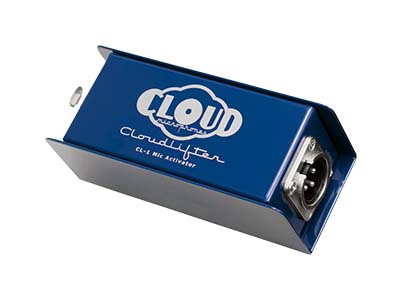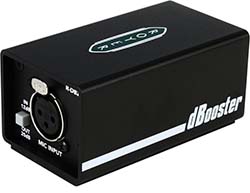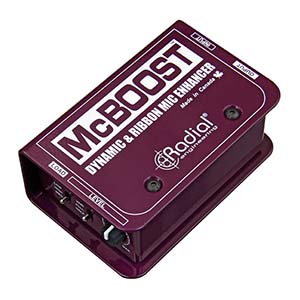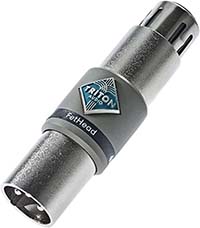What Is A Cloudlifter?
A Cloudlifter is a device that helps boost the signal from your microphone by adding 25 dB of gain before the signal even reaches your microphone preamp. This can be especially helpful if you are using a microphone with low sensitivity, like the Shure SM7B.
More generally, a device like this is called an inline preamp and there are actually several options available aside from the Cloudlifter. In this post, I’m going to help you decide if you should use an inline preamp.
We’ll set up audio comparisons so that you can hear the difference, I’ll ask you a few simple questions to help you determine if you need one, and at the end of the post, I’ll introduce you to some other inline preamps that might just be better than the Cloudlifter at a similar price.
You can find links to all of the options within the post, and using those links will support the channel at no extra cost to you.
Do You Need A Cloudlifter?
Let’s get right into it… Do you need an inline preamp like a Cloudlifter? To answer that question, I’ve got a few questions for you…
Which Type Of Microphone Are You Using?
First, what type of microphone are you using?
Inline preamps aren’t compatible with condenser microphones. So if you’re using a condenser microphone, you can’t use an inline preamp.
If you’re using a dynamic microphone or a ribbon microphone, you can use an inline preamp, but that doesn’t necessarily mean that you should use one.
Are You Using A Noisy Microphone Preamp?
You may notice that when you turn your microphone preamp knob all the way up, you start to hear some noise. What you’re hearing is the microphone preamp’s self noise (or inherent noise).
One reason you might want to use an inline preamp is to increase the level of the microphone signal before it reaches your microphone preamp. That way you wouldn’t need to turn the mic preamp up so far, saving yourself from the excessive noise inherent to that preamp.
One common misunderstanding about inline preamps like the Cloudlifter is that they give you extra gain without any noise – and that’s just not true.
Don’t get me wrong – the inherent noise of most inline preamps is extremely low, but that’s also the case with most preamps sold today.
For example, here is the noise level with just the Focusrite Scarlett 2i2 preamp turned all the way up, compared to the noise level with an inline preamp and Focusrite preamp turned down a bit to get the same signal level.
There isn’t much of a difference.
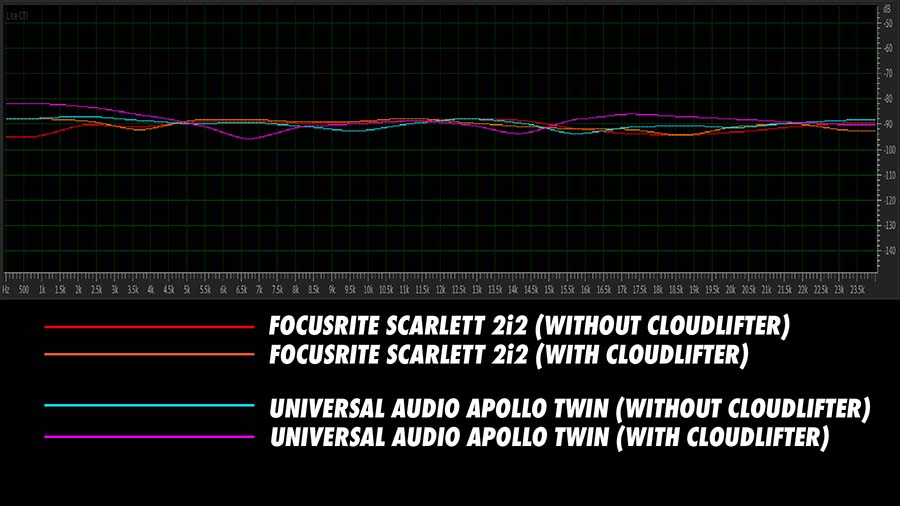
If you’re worried about noise, I’d recommend looking up the EIN in the technical specifications of your audio interface. If the EIN is -128dBu or lower, an inline preamp won’t help to significantly reduce the noise level of your recording.
However, some microphone preamps out there are quite noisy…
For example, the EIN of the Zoom H5 is -120 dBu. At this point, we will start to hear a significant difference between the noise you’ll get from the Zoom H5 preamp compared to an inline preamp.
The self noise of most modern preamps is very low and it’s rare that an inline preamp will be completely necessary based on noise levels alone.
Still, there are some other reasons aside from noise that might make an inline preamp necessary.
Are You Using A Low-Sensitivity Microphone?
I believe the most common reason why someone might want to use an inline preamp is to compensate for a low-sensitivity microphone or to simply get more gain than your preamp can provide on its own.
The sensitivity of a microphone tells us how much voltage is created at a given pressure level. Some microphones are more efficient than others when it comes to converting pressure waves into electrical currents.

The sensitivity of the Shure SM58 is 1.3mV at 1 Pa, while the Shure SM7B produces 1.12mV at 1 Pa. So, the same sound pressure level into each of these microphones will result in a different signal level into your preamp. That means the SM7B requires a bit more gain than the SM58.
This is where the gain range of your preamp becomes important. The gain range of the microphone preamps in my Focusrite Scarlett 2i2 (1st Gen) is -4dB to +46dB.
This article by Shure (shown below) states that the SM7B should be used with a preamp with at least 60 dB of gain, which means the 1st Gen Focusrite Scarlett 2i2 falls short by about 14 dB!
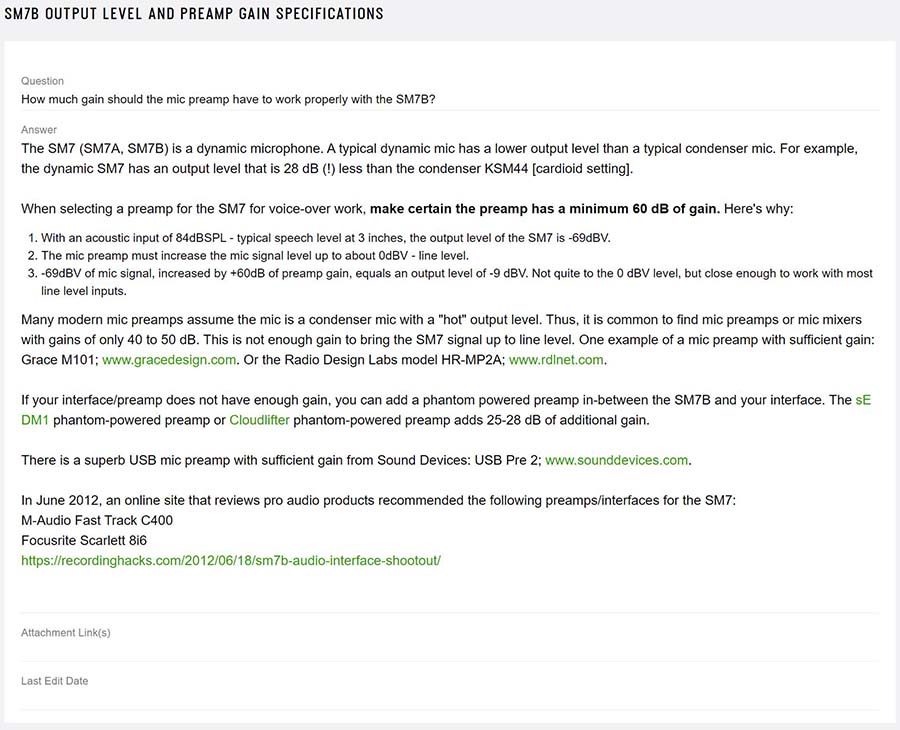
The gain range of the most current 3rd Gen Focusrite Scarlett 2i2 is 56 dB, which is a bit closer to the recommended 60 dB, but is still 4 dB short.
In both of these cases, it would be beneficial to use an inline preamp to provide the extra gain to the signal chain.
Pairing the Focusrite Scarlett 2i2 (3rd Gen) with a Cloudlifter gives the system an extra 25 dB of gain, resulting in a total of 71 dB, which is plenty for most microphones.
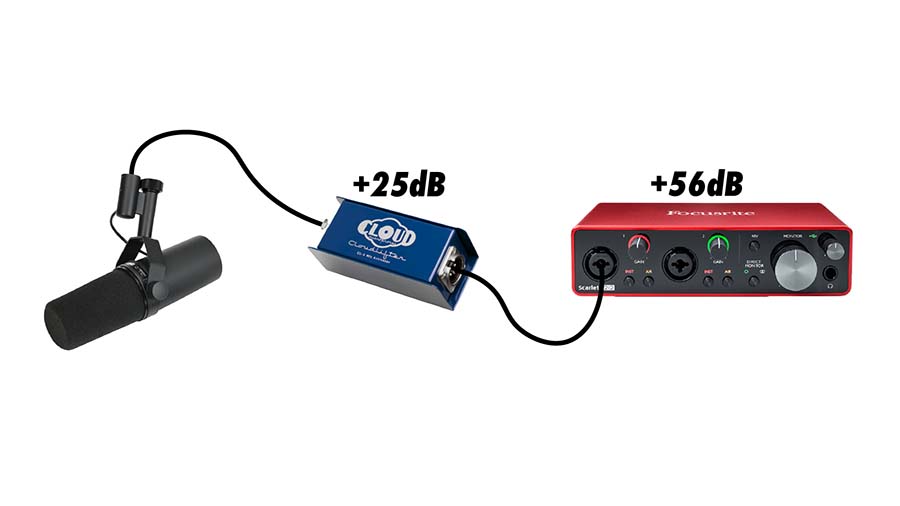
On the other hand, my UA Apollo Twin interface has a gain range of +10 dB to +65 dB, so I probably don’t need to use an inline preamp to provide the gain needed for the Shure SM7B.
I show some examples of these scenarios in the video at the top of this page.
What Is The Sound Pressure Level At The Microphone?
The last detail that should be considered is the sound pressure level at the microphone. There are a few factors that play into this.
First, how loud is the sound source?
If you are putting the SM7B on a trumpet or a snare drum, you probably don’t need to worry about the gain range of your preamp. These are very loud instruments and the stronger the signal is at the microphone, the less gain will be required.
It’s more likely that you’ll be using the SM7B for vocals or spoken word, and a human voice is much quieter by nature.
A person who projects their voice into the microphone at a strong level is less likely to need an inline preamp than someone with a very quiet speaking voice.
Not only does the level of the sound source matter, but the distance of the sound source to the microphone also matters, due to the inverse distance law. With every doubling of distance between the source and the microphone, you will see a 6 dB loss in level.
Moving closer to the microphone will increase the level, but it also changes the tonal balance of the signal, due to the proximity effect.
If you’re not able to get a good level between -18 and -12 dB Full Scale from about 3 inches from the microphone, you probably need more powerful preamps or an inline preamp.
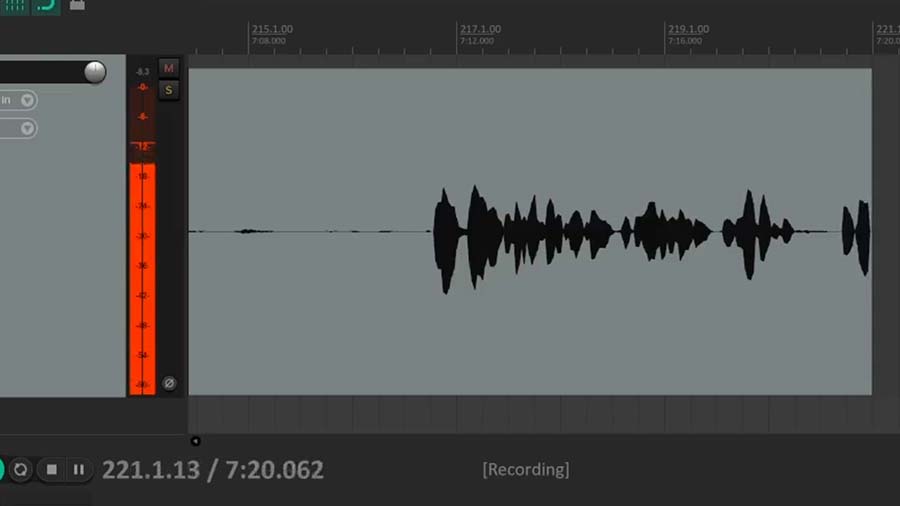
Alternative Inline Preamps
If you’ve decided that you do, in fact, need an inline preamp, then you should know that there are more options available than just the Cloudlifter.
Don’t get me wrong – the Cloudlifter is a solid option, but other options like the Radial McBoost give you a bit more flexibility.
With the Radial McBoost, I can actually fine-tune the amount of gain using this knob. I really like having that extra bit of control.
Other popular options include the Royer dBooster and the Triton FetHead.

